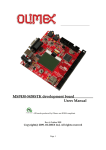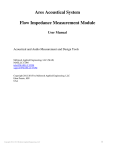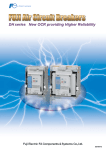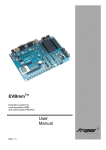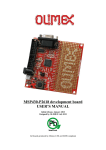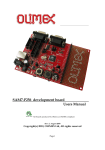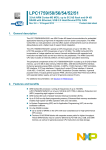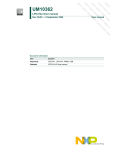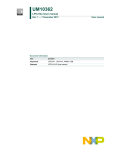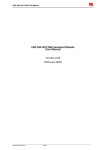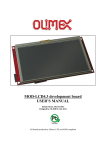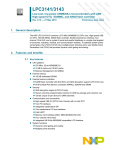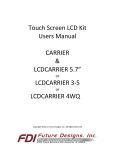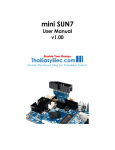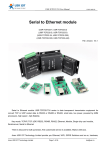Download LPC2378-STK User Manual
Transcript
LPC-2378STK development board Users Manual Rev. C, July 2009 Copyright(c) 2009, OLIMEX Ltd, All rights reserved Page 1 INTRODUCTION: LPC-2378STK is a starter kit which uses Microcontroller LPC2378 from NXP. This microcontroller supports various serial interfaces such as USB 2.0, UART, CAN, etc. In addition you will find also audio input and output, JTAG, Ethernet, TFT display and SD/MMC card holder on this board. All this along allow you to build a diversity of powerful applications to be used in a wide range of situations. BOARD FEATURES: − − − − − − − − − − − − − − − − − − − − − − − − − MCU: LPC2378 16/32 bit ARM7TDMI-S™t with 512K Bytes Program Flash, 16K Bytes RAM, EXTERNAL MEMORY BUS, RTC, 4x 10 bit ADC 2.44 uS, 2x UARTs, 4x CAN, I2C, SPI, 2x 32bit TIMERS, 7x CCR, 6x PWM, WDT, 5V tolerant I/O, up to 60MHz operation standard JTAG connector with ARM 2x10 pin layout for programming/debugging with ARM-JTAG Optional - TRACE connector 128x128 pixel 12 bit color TFT LCD with backlight Ethernet 100MBit MMA7620 3 axis accelerometer Two RS232 port Two CAN drivers and connector SD/MMC card connector UEXT connector with I2C, SPI, RS232 and power supply for connecting add-on modules like RF link, MP3, etc available from Olimex IrDA transceiver on board Audio in and Audio Out jacks for microphone and headphones trimpot connected to ADC RESET circuit with external control of Philips ISP utility via RS232 port Jumpers for ISP/RUN mode Joystick with four directions and push action two USER button RESET Button two on board voltage regulators 3V and 5V with up to 800mA current Extension port connector for many of microcontrollers pins single power supply: External power supply, USB or JTAG connector Battery holder and connector for the RTC power supply led FR-4, 1.5 mm, red soldermask, component print Dimensions: 134.60 x 101.27mm (5.3x3.99") ELECTROSTATIC WARNING: The LPC-2378STK board is shipped in protective anti-static packaging. The board must not be subject to high electrostatic potentials. General practice for working with static sensitive devices should be applied when working with this board. BOARD USE REQUIREMENTS: Cables: You will need different cables depending on the used programming/debugging tool. If you use Olimex's ARM-JTAG, you will need a LPT cable. If you use ARM-USB-OCD or ARM-USB-TINY, Page 2 you will need USB A-B cable. If you use a software programmer such as FlashMagic, you may need RS232 or other cables. Hardware: Programmer/Debugger – ARM-JTAG, ARM-USB-TINY or ARMUSB-OCD or other compatible programming/debugging tool. Software: You can use GCC or other commercial ARM compiler. PROCESSOR FEATURES: LPC-2378STK board use microcontroller LPC2378 from NXP with these features: – ARM7TDMI-S processor, running at up to 72 MHz. – Up to 512 kB on-chip flash program memory with In-System Programming (ISP) and In-Application Programming (IAP) capabilities. Flash program memory is on the ARM local bus for high performance CPU access. – 32 kB of SRAM on the ARM local bus for high performance CPU access. – 16 kB SRAM for Ethernet interface. Can also be used as general purpose SRAM. – 8 kB SRAM for general purpose DMA use also accessible by the USB. – Dual Advanced High-performance Bus (AHB) system that provides for simultaneous Ethernet DMA, USB DMA, and program execution from on-chip flash with no contention between those functions. A bus bridge allows the Ethernet DMA to access the other AHB subsystem. – EMC provides support for static devices such as flash and SRAM as well as off-chip memory mapped peripherals. – Advanced Vectored Interrupt Controller (VIC), supporting up to 32 vectored interrupts. – General Purpose AHB DMA controller (GPDMA) that can be used with the SSP serial interfaces, the I2S port, and the Secure Digital/MultiMediaCard (SD/MMC) card port, as well as for memory-to-memory transfers. – Serial Interfaces: • Ethernet MAC with associated DMA controller. These functions reside on an independent AHB bus. • USB 2.0 full-speed device with on-chip PHY and associated DMA controller. • Four UARTs with fractional baud rate generation, one with modem control I/O, one with IrDA support, all with FIFO. Page 3 • CAN controller with two channels. • SPI controller. • Two SSP controllers, with FIFO and multi-protocol capabilities. One is an alternate for the SPI port, sharing its interrupt and pins. These can be used with the GPDMA controller. • Three I2C-bus interfaces (one with open-drain and two with standard port pins). • I2S (Inter-IC Sound) interface for digital audio input or output. It can be used with the GPDMA. – Other peripherals: • SD/MMC memory card interface. • 104 General purpose I/O pins with configurable pull-up/down resistors. • 10-bit ADC with input multiplexing among 8 pins. • 10-bit DAC. • Four general purpose timers/counters with 8 capture inputs and 10 compare outputs. Each timer block has an external count input. • One PWM/timer block with support for three-phase motor control. The PWM has two external count inputs. • Real-Time Clock (RTC) with separate power pin, clock source can be the RTC oscillator or the APB clock. • 2 kB SRAM powered from the RTC power pin, allowing data to be stored when the rest of the chip is powered off. • WatchDog Timer (WDT). The WDT can be clocked from the internal RC oscillator, the RTC oscillator, or the APB clock. – Standard ARM test/debug interface for compatibility with existing tools. – Emulation trace module supports real-time trace. – Single 3.3 V power supply (3.0 V to 3.6 V). – Four reduced power modes: idle, sleep, power down, and deep power down. – Four external interrupt inputs configurable as edge/level sensitive. All pins on PORT0 and PORT2 can be used as edge sensitive interrupt sources. Page 4 – Processor wake-up from Power-down mode via any interrupt able to operate during Power-down mode (includes external interrupts, RTC interrupt, USB activity, Ethernet wake-up interrupt). – Two independent power domains allow fine tuning of power consumption based on needed features. – Each peripheral has its own clock divider for further power saving. – Brownout detect with separate thresholds for interrupt and forced reset. – On-chip power-on reset. – On-chip crystal oscillator with an operating range of 1 MHz to 24 MHz. – 4 MHz internal RC oscillator trimmed to 1 % accuracy that can optionally be used as the system clock. When used as the CPU clock, does not allow CAN and USB to run. – On-chip PLL allows CPU operation up to the maximum CPU rate without the need for a high frequency crystal. May be run from the main oscillator, the internal RC oscillator, or the RTC oscillator. – Boundary scan for simplified board testing. – Versatile pin function selections allow more possibilities for using on-chip peripheral functions. Page 5 BLOCK DIAGRAM: Page 6 MEMORY MAP: Page 7 red + Page 8 JTAG R110 10K R49 10K R50 10K R48 10K R51 10K DBG _E 2 1 TRSTN TDI TMS TCK RTCK TDO RSTN R46 10K 3.3V R47 10K CP USBC/USBSC 1 3 5 7 9 11 13 15 17 19 21 23 25 27 29 31 33 35 37 2 4 6 8 10 12 14 16 18 20 22 24 26 28 30 32 34 36 38 2 1 P2.[0..9] P3.0/D0 P3.1/D1 P3.2/D2 P3.3/D3 P3.4/D4 P3.5/D5 P3.6/D6 P3.7/D7 P3.23/CAP0.0/PCAP1.0 P3.24/CAP0.1/PWM1.1 P3.25/MAT0.0/PWM1.2 P3.26/MAT0.1/PWM1.3 VDDPLL L5 FB0805 C85 100n + GND5 GND4 GND3 GND2 GND1 C86 10u/6.3V R129 R16 3.3V C87 100n 3.3V http://www.olimex.com/dev COPYRIGHT(C) 2009 , OL IMEX Ltd. Rev. C 330 3.3V 2.5V R83 33K D4 1N4148 PHY_INT R101 R107 330 1 00n C88 R9 33k RESET 2.5V R130 LPC-2378-STK R97 330 R96 NA R98 1k 6 7 8 9 G2 D3 1N4 148 3 .3V 3 .3V 100n C20 3.3V 1 2 3 4 5 G1 6 7 8 9 G2 47 CENTER C55 NA C89 RD2 TD2 C54 0 R14 100nF 0 R13 2 +5V +5V 1:1 1:1 R37 10 K TXD VSS VDD RXD 1 RS CANH CANL VREF 2 CAN2_D MCP2551 1 2 3 4 U6 1K R52 75 75 1nF/2kV YELLOW GREEN LAN 8 7 6 5 8 7 6 5 R38 120 R35 120 75 75 6 RIGHT 5 4 UP R80 33K 1K C49 100 n BUT2 BUT1 CO N33.5MM 3 2 1 CAN2 CO N33.5MM 3 2 1 CAN1 3 7 8 6 1 4 5 2 R84 330 R81 33K R78 C21 100n RJLBC-060TC1 RS CANH CANL VREF MCP25 51 D<6> Common<5> B<4> R77 20K 3 .3V C90 100n CAN1_D 1 2 TXD VSS VDD RXD U7 1 0K R40 R11 20K 3.3V TFDU4100 IRED_ANODE IRED_CATHODE VCC1 NC GND TXD RXD SC JOYSTICK_MT5_F C<3> LEDGND GND VLED NO KIA661 0_CO LO R_LCD IRDA BUT2 E <2> Center push A<1> J1 1 2 6 5 8 3 4 7 9 8 BUT1 3.3V TD+ COM TDAG KG AY KY RD+ NC RD- R106 49.9/1% DOWN 3 330 2 LEFT 1 R10 20K 3.3V 4.7uF/6.3V R85 1 2 3 4 IR_TX C58 10K 330 10k 1 3 2 AG LED100 KG AY LEDACT KY 7 6 8 2.5V R79 33K T2 BC817 R82 33K R12 1k TD1 1 00nF RD1 100nF ISP_ E 1 IRDA_LS_E C57 15 R89 R94 R88 IR_RX R86 R87 3.3V C60 10u/6.3V 330 R74 22 Q4 BC817 RESET SCK DIO CS 1 E_TXD[0..1],E_TX_EN,E_CRS,E_RXD[0..1],E_ RX_ER,E_RX_CLK,E_MDC,E_ MDIO EXT1-28 EXT1-27 EXT1-2 6 EXT1-25 C84 100n 24 23 22 21 1K 20 1K 19 18 17 E _T XD1 16 E _T XD0 15 E _T X _E N 14 E_ RX_CLK 13 LCD_RST EXT1-3 6 EXT1-35 EXT1-34 EXT1-33 EXT1 -32 EXT1-31 EXT1-30 EXT1-29 137 140 144 2 9 12 16 19 45 40 39 38 5 6 7 8 9 10 11 12 36 35 34 33 32 31 30 29 28 27 26 25 4.99k/1% R104 1.5k/1% R10 3 MDIO GND5 MDC GND4 RXD3/PHYAD1 FXSD/FXEN RXD2/PHYAD2 RX+ RXD1/PHYAD3 RXRXD0/PHYAD4 VDDRX VDDIO1 PD# GND1 LED3/NWAYEN RXDV/CRSDV/PCS_LPBK LED2/DUPLEX RXC LED1/SPD100/NFEF RXER/ISO LED0/TEST GND2 INT/PHYAD0 VDDIO2 GND3 CRS/RMII_BTB COL/RMII TXD3 TXD2 TXD1 TXD0 TXEN TXC/REFCLK TXER VDDC VSSA VSS-9 VSS-8 VSS-7 VSS-6 VSS-5 VSS-4 VSS-3 VSS-2 VSS-1 E_ RX_ER 1 2 3.3K 3 3.3K 4 C91 + 10u/6.3V 2.5V T1 BC817 G1 RS232_0 1 2 3 4 5 RS232_1 1 00nF C50 3.3K 15 139 119 117 103 79 65 59 44 22 EXT2-24 EXT2-25 EXT2-26 EXT2-27 3.3V E_CRS E_ MDIO E_MDC R127 R128 E_RXD1 E_RXD0 VDDPLL C92 100n 2 R8 33K 1 LEDACT LED100 1 R53 10K EXT2-37 EXT2-36 EXT2-35 EXT2-34 EXT2-33 EXT2-3 2 EXT2-31 EXT2-30 EXT2 -29 EXT2 -28 P2.0 P2.1 P2.2 P2.3 P2.4 P2.5 P2.6 P2.7 P2 .8 P2.9 ISP_E MCIDAT1 MCIDAT2 MCIDAT3 107 106 105 100 99 97 96 95 93 92 76 75 73 71 10k R19 FB0805 L4 VSS 4 RSTN ISP_E D2 1N4148 3.3V RST_E 3 G S11 /GS10 + NA R75 R73 10 BL_PW R 2 VDISPLAY VDIGITAL LCD 2 NA P2.0 P2.1 P2.2 P2.3 P2.4 P2.5 P2.6 P2.7 P2 .8 P2.9 EXT2-40 EXT2-39 EXT2-38 P2.0/PWM1.1/TXD1/TRACECLK P2.1/PWM1.2/RXD1/PIPESTAT0 P2.2/PWM1.3/CTS1/PIPESTAT1 P2.3/PWM1.4/DCD1/PIPESTAT2 P2.4/PWM1.5/DSR1/TRACESYNC P2.5/PWM1.6/DTR1/TRACEPKT0 P2.6/PCAP1.0/RI1/TRACEPKT1 P2.7/RD2/RTS1/TRACEPKT2 P2.8/TD2/TXD2/TRACEPKT3 P2.9/U1CONNECT/RXD2/EXTIN0 P2.10/#EINT0 P2.11/#EINT1/MCIDAT1/I2STX_CLK P2.12/#EINT2/MCIDAT2/I2STX_WS P2.13/#EINT3/MCIDAT3/I2STX_SDA OUT VDD CD1 13 8 14 7 C16 100n C17 100n R7 33k 3.3V C34 1 00n 3.3K 3.3K 1K 6NC2-50MHz RSTN U4 KS87 21BL C96 1 0u/6.3V 3.3V E/D GND 15 R1IN R2IN U2PWR VCC 16 MAX3232 R1OUT R2OUT 100K 12 9 T1OUT T2OUT V- 6 2 1K R93 1k R72 2k R71 33K 3.3V R108 LCD_ RST 4 3 5 6 1 CAN1_T P2.4 +5V 3.3V EXT2-22 EXT1-40 R102 2K 3 .3V 3.3V NA 3 1 R18 R124 R125 R126 3.3V RXD0 E_ RXD0 E_ RXD1 E_RX_ER C95 100n R17 R123 1K E_ CRS E_RX_CLK R41 4.7K 0 T1IN T2IN C2- C2+ V+ REXT VDDRCV GND6 TXTX+ VDDTX GND7 GND8 XO XI VDDPLL RST# P2.8 P2.7 P2.6 P2.5 P2.4 P2.3 P2 .2 P2.1 P2.9 3.3V P2.0 VIN P4.31/#CS1 P4.30/#CS0 P4.29/MAT2.1/RXD3 P4.28/MAT2.0/TXD3 P4.25/#WE P4.24/#OE P4.15/A15 P4.14/A14 P4.13/A13 P4.12/A12 P4.11/A11 P4.10/A10 P4.9/A9 P4.8/A8 P4.7/A7 P4.6/A6 P4.5/A5 P4.4/A4 P4.3/A3 P4.2/A2 P4.1/A1 P4.0/A0 E_TXD0 E_TXD1 E_TX_EN E_CRS E_ RXD0 E_RXD1 E_RX_ER E_RX_CLK E_MDC E_MDIO UP DO W N SCK0 SSEL0 RIG HT MISO 0 EXT2 -19 MO SI0 R11 5 10k CENTER LCD_BL EXT2-20 LEFT G _SEL2 EXT2-1 7 WP +5V_USB EXT2-1 3 EXT2-21 AIN5 EXT2-14 136 135 133 132 131 129 128 126 125 123 46 47 49 50 51 53 54 56 57 61 63 64 30 28 R39 4 .7K R15 5 11 10 C1- C1+ U2 4 3 12 3.3V LCD_BL R68 1.2k/1% 3.3V SCK0 MISO 0 SSEL0 3.3V RJ45 SIDE ETM_E TRACE NA EXT1-7 EXT1-8 EXT1-9 EXT1-10 EXT1-11 EXT1 -12 EXT1-13 EXT1-14 EXT1-15 EXT1-16 EXT1-17 EXT1-18 EXT1-19 EXT1-20 EXT1-21 EXT1 -22 EXT1-23 EXT1-24 IR_RX IR_TX 134 130 122 118 124 127 120 110 108 104 101 94 91 88 84 78 74 72 68 58 55 52 ALARM DBGEN P1.0/ENET_TXD0 P1.1/ENET_TXD1 P1.4/ENET_TX_EN P1.8/ENET_CRS P1.9/ENET_RXD0 P1.10/ENET_RXD1 P1.14/ENET_RX_ER P1.15/ENET_RX_CLK P1.16/ENET_MDC P1.17/ENET_MDIO P1.18/U1UP_LED/PWM1.1/CAP1.0 P1.19/CAP1.1 P1.20/PWM1.2/SCK0 P1.21/PWM1.3/SSEL0 P1.22/MAT1.0 P1.23/PWM1.4/MISO0 P1.24/PWM1.5/MOSI0 P1.25/MAT1.1 P1.26/PWM1.6/CAP0.0 P1.27/CAP0.1 P1.28/PCAP1.0/MAT0.0 P1.29/PCAP1.1/MAT0.1 P1.30/VBUS/AD0.4 P1.31/SCK1/AD0.5 EXT2-18 EXT2-16 EXT2-23 EXT2-15 3.3V 3.3V RXD1 TXD1 TXD0 C19 100n 4 3 C18 100n 1 Z_O UT + 37 38 39 40 41 42 43 44 45 46 47 48 EXT1-3 9 EXT1-5 EXT1-6 EXT1-3 EXT1-4 6 26 #RESET #RSTOUT RTCK TCK #TRST TMS TDI TDO X1 X2 RTCX1 RTCX2 MCICLK MCICMD MCIPWR MCIDAT0 Y_O UT X_O UT MIC_IN AO UT SDA0 SCL0 BUT1 PHY_INT U2D+ U2D- R22 4.7K RD1 3.3V R23 TD1 4.7K 3.3V TXD0 RXD0 RD2 3.3V 3.3V TD2 P0.6/SSEL1 EXT2-1 P0.7/SCK1 EXT2-2 P0.8/MISO 1 R24 R36 EXT2-3 P0 .9/MO SI1 4.7K 4.7K EXT2 -4 TXD2 EXT2-5 RXD2 EXT2-6 Z_OUT EXT2-7 USB_LINK EXT2-8 USB_CO NNECTEXT2-9 TXD1 EXT2-10 RXD1 EXT2-1 1 CP EXT2-12 BUT2 Y_O UT MMA7260Q VSS VDD #SM G_SEL1 G_SEL2 5 R69 5.6k/1% R100 EXT1-38 EXT1-37 EXT1-2 ALARM DBGEN 24 RSTO UTN 20 NA 143 7 5 4 3 1 31 33 Q2 32768/6 p 23 25 VDD-6 VDD-5 VDD-4 VDD-3 VDD-2 VDD-1 VDD1.8-3 VDD1.8-2 VDD1.8-1 66 67 141 142 116 115 113 112 111 109 69 70 29 32 48 89 90 87 86 85 83 82 80 13 11 10 8 35 34 42 43 36 37 R66 1K NC1 NC2 NC3 NC4 NC5 NC6 NC7 NC8 1 2 MC34063 FB SC SE BL_PWR R95 49.9/1% 3.3V NA EXT1-1 RSTN RST_O UT RTCK TCK TRSTN TMS TDI TDO 98 81 21 138 114 102 77 62 41 U1 LPC2378 47n 2 C51 100n 5 6 7 8 9 10 11 16 U8 G-SEL1 G-SEL2 TC 1 2 150 D5 1N5819 S R105 R99 +5V VIN R20 1k R6 3.3V GND Q1 12.000 MHz 22p C13 22p C12 15p C15 1 5p C14 C22 1.8_ CO RE NA NA 10 C41 LM386 P0.0/RD1/TXD3/SDA1 P0.1/TD1/RXD3/SCL1 P0.2/TXD0 P0.3/RXD0 P0.4/I2SRX_CLK/RD2/CAP2.0 P0.5/I2SRX_WS/TD2/CAP2.1 P0.6/I2SRX_SDA/SSEL1/MAT2.0 P0.7/I2STX_CLK/SCK1/MAT2.1 P0.8/I2STX_WS/MISO1/MAT2.2 P0.9/I2STX_SDA/MOSI1/MAT2.3 P0.10/TXD2/SDA2/MAT3.0 P0.11/RXD2/SCL2/MAT3.1 P0.12/MISO1/AD0.6 P0.13/U2UP_LED/MOSI1/AD0.7 P0.14/U2CONNECT/SSEL1 P0.15/TXD1/SCK0/SCK P0.16/RXD1/SSEL0/SSEL P0.17/CTS1/MISO0/MISO P0.18/DCD1/MOSI0/MOSI P0.19/DSR1/MCICLK/SDA1 P0.20/DTR1/MCICMD/SCL1 P0.21/RI1/MCIPWR/RD1 P0.22/RTS1/MCIDAT0/TD1 P0.23/AD0.0/I2SRX_CLK/CAP3.0 P0.24/AD0.1/I2SRX_WS/CAP3.1 P0.25/AD0.2/I2SRX_SDA/TXD3 P0.26/AD0.3/AOUT/RXD3 P0.27/SDA0 P0.28/SCL0 P0.29/U1D+ P0.30/U1DP0.31/U2D+ U2D- R64 100uF/16V X_O UT R122 1k R90 1k XOUT YOUT ZOUT 3 U3 L1 220u R70 NA RST,RTCK,TCK,TRSTN,TMS,TDI,TDO R109 10K 1 3 5 7 9 11 13 15 17 19 +5V_JLINK 1 SD-CARD CP1 CP2 CP_E 2 13 15 C23 NA 1-L HEADPHO NE VDC_DC3V3-3 VDC_DC3V3-2 VDC_DC3V3-1 VDDA VREF VBAT 3.3V 2 3-R C42 C52 100n R121 1k C53 100n R91 1k 15 14 13 C47 470p + 2.2 R67 49.9/1% 49.9/1% RSTN TDO RTCK TCK TMS TDI TRSTN 2 4 6 8 10 12 14 16 18 20 33K 2K 2 + 47uF/6.3V C59 R44 R45 1 100n C8 3.3V_E 100n C6 100n C5 100n C4 100n C3 100n C2 100n C1 3.3V 100n C9 121 60 18 14 17 27 D1 BAT54C + 3 R120 1k 47p C40 MIC_IN C48 10u/6.3V +5V 1 2 C33 100n 3.3V MCICLK MCIDAT0 MCIDAT1 MCIDAT2 C10 100n C7 100n 1 00n C11 BAT_HOLDER + 8 5 R65 33K R92 1k Z1 100 BZV5 5C2V4 Z2 BZV55C2 V4 C44 AO UT 1 00n 47p C25 R60 R114 33K UEXT-1 UEXT-2 UEXT-3 UEXT-4 UEXT-5 UEXT-6 UEXT-7 UEXT-8 UEXT-9 UEXT-10 1 2 SD 470nH CD/DAT3/CS CMD/DI VSS1 VDD CLK/SCLK VSS2 DAT0/DO DAT1/RES DAT2/RES WP1 WP2 SD/MMC WP 1 33K 33K 33K 1 2 3 4 5 6 7 8 9 10 14 2 WP_E 3.3V_REF L2 33K 2K MCIDAT3 MCICMD R43 R42 1 0 R5 1 R56 R111 R112 3.3V MCIPWR 3.3V 3.3V 3.3V 2 33K R117 33K R118 NA 18p 18p 2 R113 Q3 BC817 1K NA 3.3VA_E R32 330 C56 R119 USB_B - a udio_ jack U5 47uF/6.3V C43 +5V 1uF C38 R59 100K R58 470 K MCP601 6 U9 4 7 100n (NA) R33 33 S H IE L D 3.6V_BAT 100n C45 R2 100 K 2 3 100n C30 TXD2 RXD2 SCL0 SDA0 P0.8/MISO1 P0.9/MOSI1 P0.7/SCK1 P0.6/SSEL1 + R116 2K T4 IRLM640 2 C32 1 2 3 4 USB AN_TRIM 1 0k 47p C28 C24 1 00n R1 100K + C31 C61 10n +5V_USB DD+ + 6 1 20K R30 470 USB D- D+ R27 1.5k/1% 1 2 R26 33 BAT R34 2k R29 + R25 1K R76 R21 NA R3 10K 3.3V + U2D- 3 2 1 USBC AIN5 1-L 2 3-R a udio_ jack MIC C39 47u F/6.3V +5V 4 USB_ CO NNECT USB_LINK R31 47 0 3.3V R55 470 3.3V 4 USB_LINK T3 BC807 47uF/6.3V C26 R57 470 +5V 7 R28 10k + 3.3V 100 n C29 PWR 3.3V VSS 3.3V C37 R54 390/1% R4 240/1% OUT ADJ/GND IN VR1(3.3V) L M111 7 VCC R63 330/1% +5V 10uF/16V 47uF/6.3V C35 5 3 1 PWR_SEL 5-6 - +5V_USB 3-4 - +5V_JLINK 1-2 - +5V_EXT 6 4 2 + 100 n C27 R61 220/1% R62 330/1% +5V_USB +5V_JLINK +5V_EXT 6 3.3V OUT ADJ/GND IN VR2(5V) LM1117 DC IS GND VIN 8 7 2 U2D+ + C36 470uF/16 VDC G1 DB104(SMD) 220u/16/MINI C46 3.3V 6VAC 9 VDC PW R_JACK SCHEMATIC: CAN2_T 2 BOARD LAYOUT: Page 9 POWER SUPPLY CIRCUIT: LPC-2378STK is powered by 9VDC/6VAC applied at the power jack. LPC-2378STK could also be powered by USB (+5V_USB), JTAG (+5V_JLINK) and a battery (CR2032, Li, 3V) but this battery only powers the 2KB internal SRAM and the RTC (Real Time Clock). The consumption of LPC-2378STK is about 190 mA. RESET CIRCUIT: LPC-2378STK reset circuit is made with R8 (33k) pull-up, capacitor C20(100nF), D3 (1N4148) and the RST button. CLOCK CIRCUIT: Quartz crystal Q1 12 MHz is connected to LPC2378 pin 31 (X1) and pin 33 (X2). Quartz crystal Q2 32.768 kHz is connected to LPC2378 pin 23 (RTCX1) and pin 25 (RTCX2) and supplies the internal Real Time Clock. JUMPER DESCRIPTION: - There is jumpers description at our web page - to find it click here Page 10 INPUT/OUTPUT: SD/MMC LED (red) with name SD connected to SD/MMC pin 4. Power-on LED (red) with name PWR – this LED shows that +3.3V is applied to the board. USB_CONNECTED LED (red) with name USBC – connected to LPC2378 pin 48 (P0.14/U2CONNECT/SSEL1). USB-UP LED (red) with name USB_LINK – connected to LPC2378 pin 32 (P0.13/U2UP_LED/MOSI1/AD0.7). User button with name BUT1 connected to LPC2378 pin 42 (P0.29/U1D+). User button with name BUT2 connected to LPC2378 pin 86 (P0.18/DCD1/MOSI0/MOSI). Reset button with name RESET connected to LPC2378 pin 24 (#RESET). Trimpot with name AN_TRIM connected to LPC2378 pin 28 (P1.31/SCK1/AD0.5). TFT display - 128x128 12 bit color with backlight. Joystick button with name J1 this is 4 directions plus center button, in the schematic the joystick four directions switches are connected through 33k resistors to LPC2378 pins 51 (P1.22/MAT1.0) – RIGHT, 61 (P1.27/CAP0.1) – LEFT, 47 (P1.19/CAP1.1) – DOWN, 46 (P1.18/U1UP_LED/PWM1.1/CAP1.0) – UP, the center button is connected to pin 56 (P1.25/MAT1.1). Page 11 EXTERNAL CONNECTORS DESCRIPTION: JTAG: Pin # Signal Name Pin # Signal Name 1 +3.3V 2 +3.3V 3 TRSTN 4 GND 5 TDI 6 GND 7 TMS 8 GND 9 TCK 10 GND 11 RTCK 12 GND 13 TDO 14 GND 15 RSTN 16 GND 17 Pull-down 18 GND 19 +5V_JLINK 20 GND PWR_JACK: Pin # Signal Name 1 Power Input 2 GND Page 12 RS232_0: Pin # Signal Name 1 Not Connected 2 T2OUT 3 R2IN 4 This signal controls microcontroller reset signal 5 GND 6 Not Connected 7 This signal controls microcontroller ISP_E signal 8 Not Connected 9 Not Connected This is standard DB9 RS232 female type connector. RS232_1: Pin # Signal Name 1 Not Connected 2 T1OUT 3 R1IN 4 Not Connected 5 GND 6 Not Connected 7 Not Connected 8 Not Connected 9 Not Connected Page 13 HEADPHONE: Pin # Signal Name 1-L Audio Left OUT 2-C GND 3-R Audio Right OUT This is 3.5 mm Audio jack female connector and work with most standard 3.5 mm jack headphones. Note the signal is Mono i.e. Left and Right channel info is same. MIC: Pin # Signal Name 1-L Audio Left IN 2-C GND 3-R Not Connected IrDA: Pin # Signal Name 1 +3.3V 2 NC 3 IR_TX (pull-down via R89(10k)) 4 IR_RX 5 NC 6 +3.3V 7 NC 3.3V/GND – look at jumper IRDA_LS_E 8 GND Page 14 SD/MMC: Pin # Signal Name Pin # Signal Name 1 MCIDAT3 2 MCICMD 3 GND 4 MCIPWR 5 MCICLK 6 GND 7 MCIDAT0 8 MCIDAT1 9 MCIDAT2 10 Pull-up/WP 11 - 12 - 13 Pull-up/CP 14 Pull-down 15 Pull-down This is standard SD-MMC card connector. CAN1: Pin # Signal Name 1 GND 2 CANL 3 CANH CANL and CANH are either deferential input, or differential output depending on the function of the MCP2551 CAN controller (receiving or transmitting data). CAN2: Pin # Signal Name 1 GND 2 CANL 3 CANH Page 15 EXT1: Pin # Signal Name Pin # Signal Name 1 RSTN 2 ALARM 3 EXT1_3 4 EXT1_4 5 IR_RX 6 IR_TX 7 EXT1_7 8 EXT1_8 9 EXT1_9 10 EXT1_10 11 EXT1_11 12 EXT1_12 13 EXT1_13 14 EXT1_14 15 EXT1_15 16 EXT1_16 17 EXT1_17 18 EXT1_18 19 EXT1_19 20 EXT1_20 21 EXT1_21 22 EXT1_22 23 EXT1_23 24 EXT1_24 25 EXT1_25 26 LCD_RST 27 EXT1_27 28 EXT1_28 29 EXT1_29 30 EXT1_30 31 EXT1_31 32 EXT1_32 33 EXT1_33 34 EXT1_34 35 EXT1_35 36 EXT1_36 37 VIN 38 +5V 39 3.3V 40 GND Page 16 EXT2: Pin # Signal Name Pin # Signal Name 1 P0.6/SSEL1 2 P0.7/SCK1 3 P0.8/MISO1 4 P0.9/MOSI1 5 TXD2 6 RXD2 7 Z_OUT 8 USB_LINK 9 USB_CONNECT 10 TXD1 11 RXD1 12 CP 13 WP 14 AIN5 15 X_OUT 16 AOUT 17 G_SEL2 18 PHY_INT 19 MISO0 20 LCD_BL 21 +5V_USB 22 VIN 23 Y_OUT 24 ISP_E 25 MCIDAT1 26 MCIDAT2 27 MCIDAT3 28 P2.9 29 P2.8 30 P2.7 31 P2.6 32 P2.5 33 P2.4 34 P2.3 35 P2.2 36 P2.1 37 P2.0 38 +5V 39 3.3V 40 GND Page 17 UEXT: Pin # Signal Name 1 +3.3V 2 GND 3 TXD2 4 RXD2 5 SCL0 6 SDA0 7 P0.8/MISO1 8 P0.9/MOSI1 9 P0.7/SCK1 10 P0.6/SSEL1 USB: Pin # Signal Name 1 +5V_USB 2 U2D- 3 U2D+ 4 GND U1D-, U1D+ I/O This signals form the differential input/output depending on the direction of the data transfer. BAT Pin # Signal Name 1 2V - 3.6V 2 GND Page 18 LAN: Pin # Signal Name Chip Side Pin # Signal Name Chip Side 1 TD+ 5 Not Connected (NC) 2 TD- 6 Not Connected (NC) 3 2.5V 7 RD+ 4 Not Connected (NC) 8 RD- LED Color Usage Right Yellow Activity Left Green 100MBits/s (Half/Full duplex) TD- Output Differential signal output. This signal is output from the MCU. TD+ Output Differential signal output. This signal is output from the MCU. RD- Input Differential signal input. This signal is input for the MCU. RD+ Input Differential signal input. This signal is input for the MCU. TRACE (optional): The TRACE connector allows you to trace the execution of the programs. Page 19 MECHANICAL DIMENSIONS: Page 20 AVAILABLE DEMO SOFTWARE: – AudioDevice_demo – GettingStarted_demo – LCD_Demo – MassStorage_demo – simple_demo – uip_webserver_demo – USBMouse_demo – VirtualCom_demo Page 21 ORDER CODE: LPC-2378STK – assembled and tested (no kit, no soldering required) How to order? You can order to us directly or by any of our distributors. Check our web www.olimex.com/dev for more info. All boards produced by Olimex are RoHS compliant Revision history: REV.C - created July 2009 Page 22 Disclaimer: © 2009 Olimex Ltd. All rights reserved. Olimex®, logo and combinations thereof, are registered trademarks of Olimex Ltd. Other terms and product names may be trademarks of others. The information in this document is provided in connection with Olimex products. No license, express or implied or otherwise, to any intellectual property right is granted by this document or in connection with the sale of Olimex products. Neither the whole nor any part of the information contained in or the product described in this document may be adapted or reproduced in any material from except with the prior written permission of the copyright holder. The product described in this document is subject to continuous development and improvements. All particulars of the product and its use contained in this document are given by OLIMEX in good faith. However all warranties implied or expressed including but not limited to implied warranties of merchantability or fitness for purpose are excluded. This document is intended only to assist the reader in the use of the product. OLIMEX Ltd. shall not be liable for any loss or damage arising from the use of any information in this document or any error or omission in such information or any incorrect use of the product. Page 23























